Examine the AOS-CX configuration:

The switches have a default factory password setting NetEdit fails to access the configuration of the AOS-CX switches. What should the administrator do to solve this problem?
When implementing deficit weighted round robin queuing, what importance does the weight value have?
In AOS-CX switching, what determines when a frame is forwarded by the switch between the ingress and the egress port?
A network has two AOS-CX switches connected to two different service providers. The administrator is
concerned about bandwidth consumption on the service provider links and learned that the service providers were using the company as a transit AS.
Which feature should the administrator implement to prevent this situation?
An administrator has an aggregation layer of 8325CX switches configured as a VSX pair. The administrator is
concerned that when OSPF network changes occur, the aggregation switches will respond to the changes
slowly, and this will affect network connectivity, especially VoIP calls, in the connected access layer switches.
What should the administrator do on the aggregation layer switches to alleviate this issue?D18912E1457D5D1DDCBD40AB3BF70D5D
How is voice traffic prioritized correctly on AOS-CX switches?
Which concept is implemented using Aruba’s dynamic segmentation?
A network engineer is setting up BGP on AOS-CX switches. The engineer is establishing two different eBGP peering’s to two different service providers. The engineer has dozens of contiguous C-class public networks that need to be advertised to the two service providers. The engineer manually defines the networks to be advertised individually with the "network" command.
How can an administrator advertise only a summarized route to the two service providers?
Examine the following AOS-CX switch configuration:

Which access control entries would allow web traffic to the web servers 10.1.0.100 and 10.1.1.100?
Examine the following AOS-CX configuration:
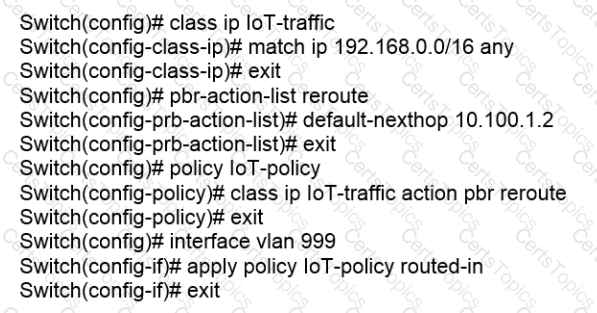
Based on this configuration, which statement is correct regarding IoT traffic?
A network engineer is examining NAE graphs from the Dashboard but notices that the time shown in the graph does not represent the current time. The engineer verifies that the AOS-CX switch is configured for NTP and is successfully synchronized. What should be done to fix this issue?
An administrator of a large campus network needs a solution that will provide root cause analytics to quickly identify problems so that they can quickly be fixed.
Which AOS-CX switch feature should the administrator utilize to help with root cause analytics?
A network administrator needs to replace an antiquated access layer solution with a modular solution involving AOS-CX switches. The administrator wants to leverage virtual switching technologies. The solution needs to support high-availability with dual-control planes.
Which solution should the administrator implement?
When an AOS-CX switch uses a temporary copy of the Configuration State database, what kind of analysis does NetEdit perform to ensure that the configuration is correct?
An administrator wants to track what configuration changes were made on a switch. What should the
administrator implement to see the configuration changes on an AOS-CX switch?
What is correct regarding rate limiting and egress queue shaping on AOS-CX switches?
Examine the VSX-related configuration of the core layer AOS-CX switch:
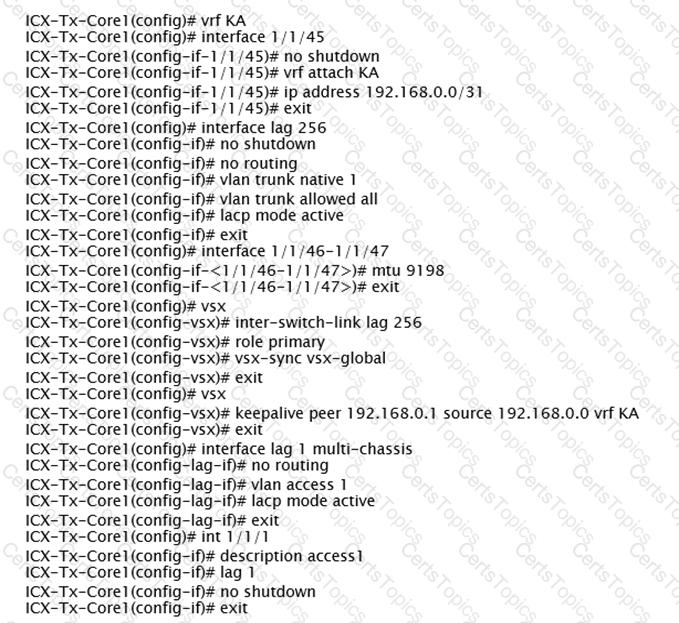
A network administrator is troubleshooting a connectivity issue involving the VSX LAG (link aggregation) between the core and access layer switch, during HW replacement of one of the core switches.
Which configuration should the administrator add to the core switch to fix this issue?
An administrator is managing a network comprised of AOS-CX switches deployed at the aggregation layer. The switches are paired in a VSX stack and run the OSPF routing protocol. The administrator is concerned about how long it takes for OSPF to converge when one of the VSX switches has to reboot.
What should the administrator to do speed up the OSPF convergence of the switch that is rebooting?
A company has an existing wireless solution involving Aruba APs and Mobility controllers running 8.4 code.
The solution leverages a third-party AAA solution. The company is replacing existing access switches with AOS-CX 6300 and 6400 switches. The company wants to leverage the same security and firewall policies for both wired and wireless traffic.
Which solution should the company implement?
A network engineer is using NetEdit to manage AOS-CX switches. The engineer notices that a lot of thirdparty VoIP phones are showing up in the NetEdit topology. The engineer deletes these, but they are
automatically rediscovered by NetEdit and added back in.
What should the administrator do to solve this problem?
A company has just purchased AOS-CX switches. The company has a free and open-source AAA solution.
The company wants to implement access control on the Ethernet ports of the AOS-CX switches.
Which security features can the company implement given the equipment that they are using?
An AOS-CX switch is configured to implement downloadable user roles. Examine the AOS-CX switch output:
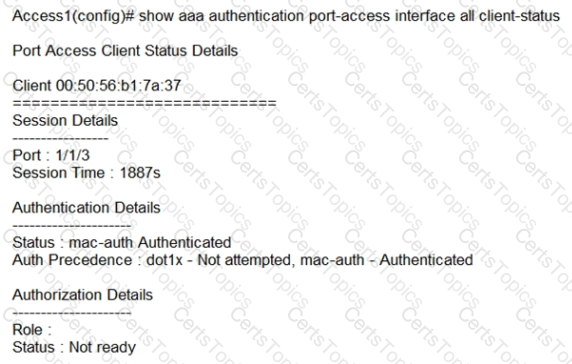
Based on this output, what is the state of the user’s access?
An administrator wants to use an existing Aruba gateway's firewall policies to filter both wireless and wired traffic. Which AOS-CX switch feature should a customer implement to ensure the gateway applies the same or similar firewall policies to users' wired and wireless traffic?
A network engineer is having a problem adding a custom-written script to an AOS-CX switch’s NAE GUI. The script was written in Python and was successfully added on other AOS-CX switches. The engineer examines the following items from the CLI of the switch:
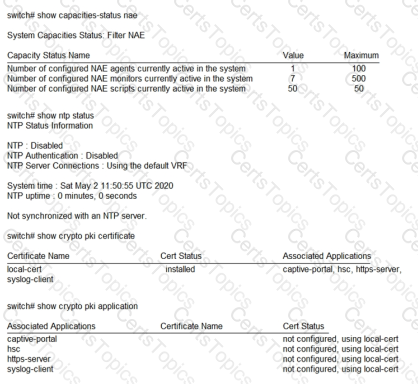
What should the engineer perform to fix this issue?
An administrator is implementing a downloadable user role solution involving AOS-CX switches. The AAA
solution and the AOS-CX switches can successfully authenticate users; however, the role information fails to
download to the switches. What policy should be added to an intermediate firewall to allow the downloadable
role function to succeed?
A network engineer for a company with 896 users across a multi-building campus wants to gather statistics on an important switch uplink and create actions based on issues that occur on the uplink. How often does an NAE agent gather information from the current state database in regard to the uplink interfaces?
An administrator will be deploying HPE Aruba Networking Switch Multi-Edit Software to manage an Aruba solution. What does Switch Multi-Edit Software support?
An administrator wants to implement a virtual switching technology that implements a single control-plane solution. Which S-CX switches would meet these criteria?
An administrator is managing a VSX pair of AOS-CX switches An administrator configures the following on the primary AOS-CX switch:

How is NetEdit installed at a customer location?
An administrator is looking for a data center switching solution that will greatly reduce the likelihood of dropped
frames when uplink congestion is experienced. Which AOS-CX switch queuing feature meets the
administrator’s needs?
A network administrator is attempting to troubleshoot a connectivity issue between a group of users and a
particular server. The administrator needs to examine the packets over a period of time from their desktop;
however, the administrator is not directly connected to the AOS-CX switch involved with the traffic flow.
What is correct regarding the ERSPAN session that needs to be established on an AOS-CX switch? (Choose two.)
Examine the network exhibit:
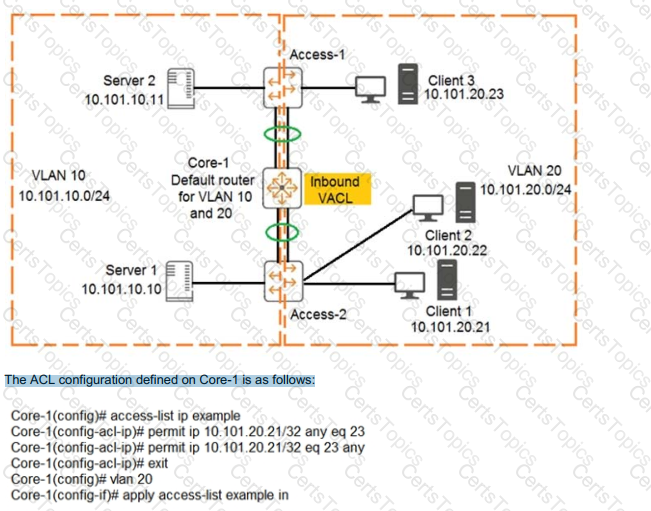
The ACL configuration defined on Core-1 is as follows:
If telnet was being used, which device connection would be permitted and functional in both directions?
(Choose two.)
An administrator has configured the following on an AOS-CX switch:
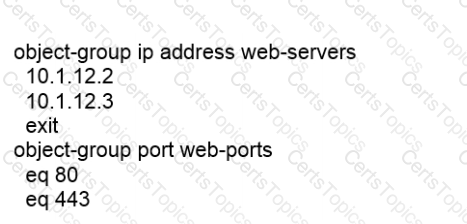
What is the correct ACL rule configuration that would allow traffic from anywhere to reach the web ports on the
two specified servers?
Examine the attached diagram

Two AOS-CX switches are configured for VSX at the access layer, where servers attached to them. An SVI interface is configured for VLAN 10 and serves as the default gateway for VLAN 10. The ISL link between the switches fails, but the keepalive interface functions. Active gateway has been configured on the switches.
What is correct about access from the servers to the Core?
Examine the network exhibit:
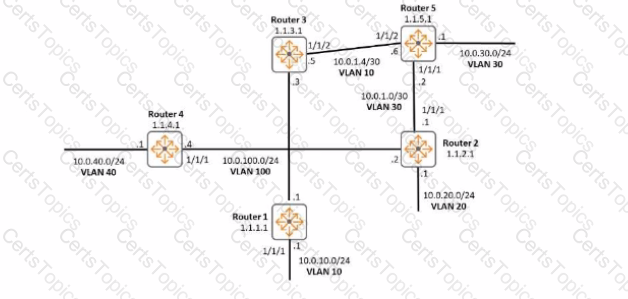
Examine Rome r4"s partial OSPF configuration: router OSPF 1
Area 0
exit interface vlan 100
ip ospf area 0
exit interface vlan 40
ip ospf area 0
exit interface 1/1/1
vlan access 100
mtu9000
Ip ospt hello-Interval 1
Ip ospt dead-Interval 4
ip ospf authentication simple-text
ip ospf authentication-key key123
When executing the "show ip ospf neighbors" command, Router 4 is in a FULL state with Router 3 and Router 2, but a 2-WAY state with Route3. What is causing the 2-WAY state with Router 1?
Examine the following ACL rule policies:
Permit traffic from 10.2.2.1 through 10.2.2.30 to anywhere
Permit traffic from 10.2.2.40 through 10.2.2.55 to anywhere
Deny all others
Based on this policy, place the following ACL rule statements in the correct order to accomplish the above
filtering policy.
Which statement is correct regarding ACLs and TCAM usage?